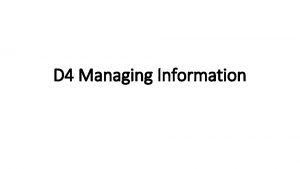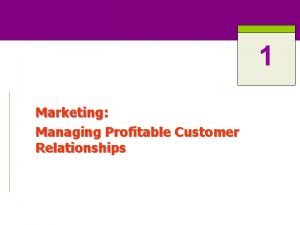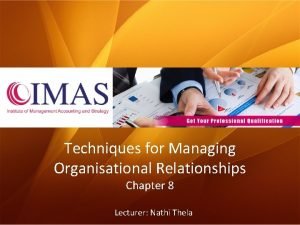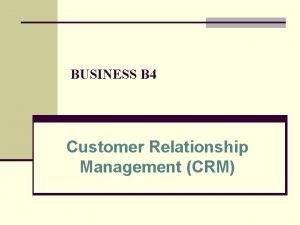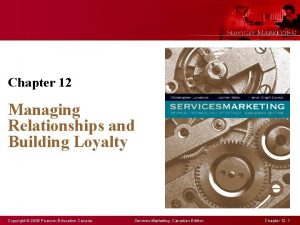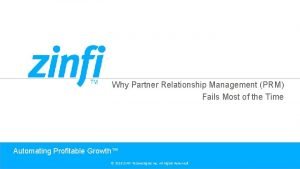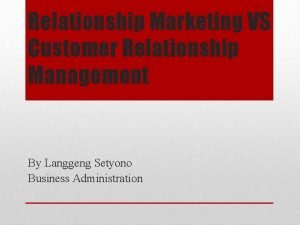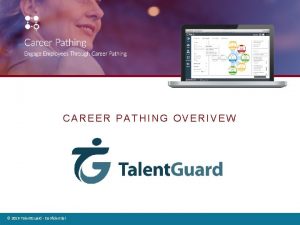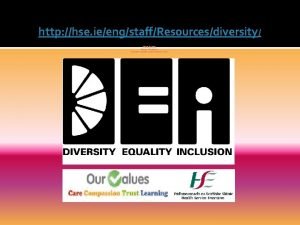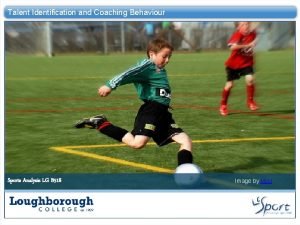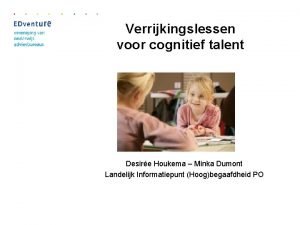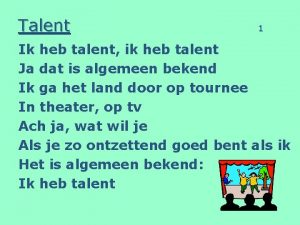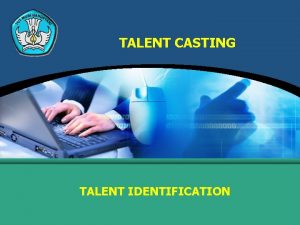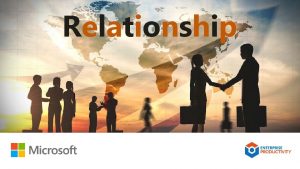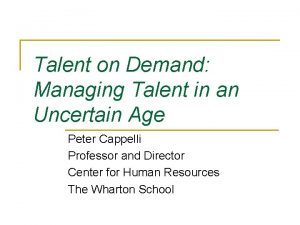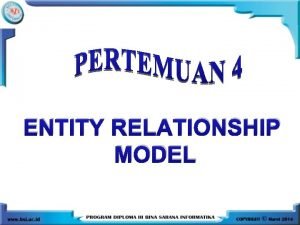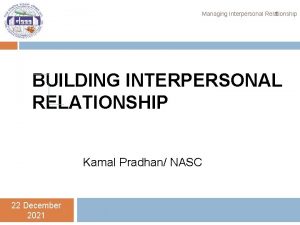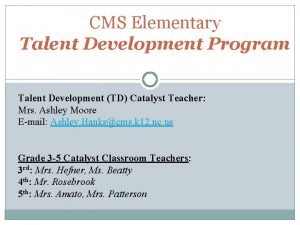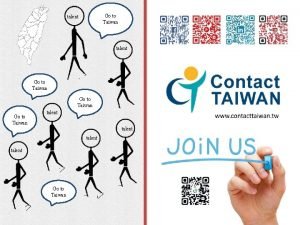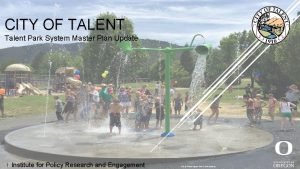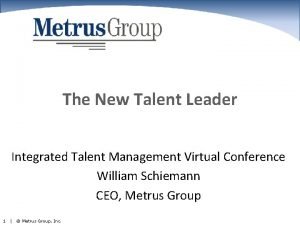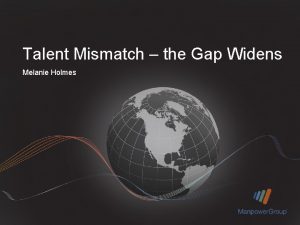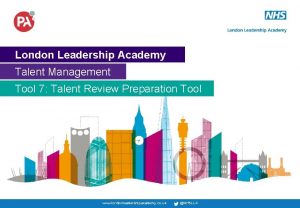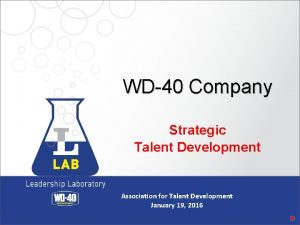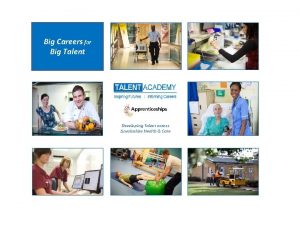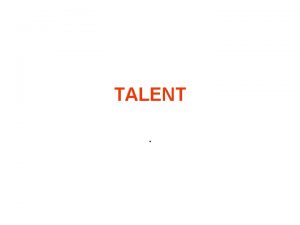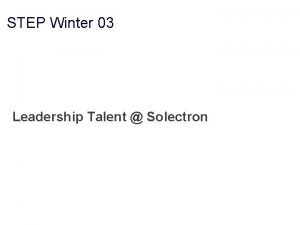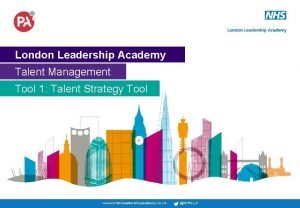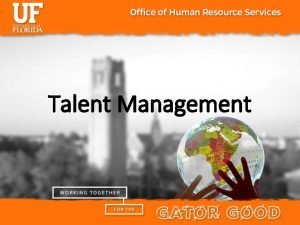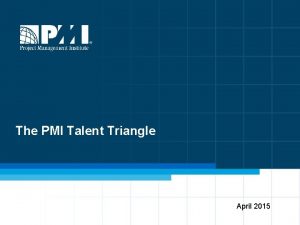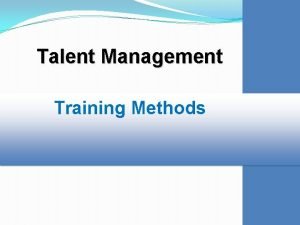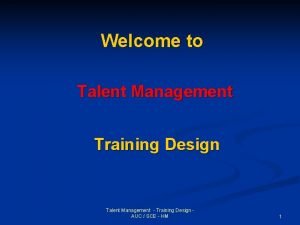EMPLOYMENT PRACTICES Managing talent in the employment relationship























































- Slides: 55

EMPLOYMENT PRACTICES (Managing talent in the employment relationship) 1/20/2022 (Employment Practices) 1

EMPLOYMENT PRACTICES (Managing talent in the employment relationship) 1/20/2022 (Employment Practices) 2

MAS 367: EMPLOYMENT PRACTICES (Managing talent in the employment relationships) 1/20/2022 (Employment Practices) 3

MAS 367: EMPLOYMENT PRACTICES (Managing talent in the employment relationship) 1/20/2022 (Employment Practices) 4

Part (unit) two: pre-recruitment practices 1 • Human resource planning • Job analysis 1/20/2022 (Employment Practices) 5

Human resource planning 1/20/2022 (Employment Practices) 6

LEARNING OBJECTIVES After completing this lecture, you should be able to: Ø Define human resource planning. Ø Identify the advantages of integrating human resources planning and strategic planning. Ø Outline the type of information required as the basis for human resource planning. Ø Identify the three main stages involved in human resource planning. 1/20/2022 (Employment Practices) 7

introduction Ø “Competing through people” means that human resource (HR) expenditures must be viewed as strategic investments. Ø However, whatever the strategy or talent management strategy adopted by an organisation, it is recognised that an unrelenting and increasing rate of change is an unavoidable phenomenon. Ø The implication is that tomorrow’s workplace will not be the same as todays. 1/20/2022 8

introduction Ø This highlights the need for human resource planning which responds to this situation by taking a long term view and works towards preparing an organisation to cope with its future requirements” (Foot and Hook, 2005) 1/20/2022 9

INTRODUCTION Ø This suggests that effective management decides where an organisation will need to go, how to get there, and then regularly evaluate to see whether the organisation is on track. (Mathis and Jackson, 2004). Ø This is where an organisation’s business strategy, and its human resource practices and policies become integrated. 1/20/2022 (Employment Practices) 10

INTRODUCTION Ø This highlights the need for human resource planning (HRP) which responds to this situation by taking a long view and works towards preparing an organisation to cope with its future requirements and achieve its strategic objectives. Ø This is because it has been suggested that strategically designed and implemented employment systems increase the value of firm. 1/20/2022 (Employment Practices) 11

STRATEGY PLANNING AND HUMAN RESOURCE PLANNING Ø Strategic planning involves a set of procedures for making decisions about the organisation's long term goals and strategies. Ø The strategic plans especially focus on how the organisation will position itself in relation to its competitors in order to ensure its long term survival, create value, and grow. 1/20/2022 (Employment Practices) 12

STRATEGY PLANNING AND HUMAN RESOURCE PLANNING Ø Strategic human resources management (SHRM) combines strategic planning and HR planning. Ø SHRM can be thought of as the pattern of human resources deployment and activities that enable an organisation to achieve its strategic goals. 1/20/2022 (Employment Practices) 13

STRATEGIC HRM Ø Strategic HRM is the pattern of human resources deployment and activities that enable an organisation to achieve its strategic goals. Ø It involves the use of employees to achieve greater organisational effectiveness and hence gain or maintain competitive advantage. Ø “It is the link or vertical integration between human resource practices and an organisation’s business strategy, in order to enhance performance” (Schuler and Jackson, 1987) 1/20/2022 (Employment Practices) 14

THE HUMAN RESOURCE PLANNING (HRP) Ø Human Resource Planning is: ‘the process of anticipating and making provision for the movement (flow) of people into, within, and out of an organisation. (Snell and Bohlander, 2010) Ø ‘the process of analysing and identifying the need for and availability of human resources so that the organization can meet its objectives. (Mathis and Jackson, 2004: 56) 1/20/2022 (Employment Practices) 15

HUMAN RESOURCE planning AND STRATEGY Ø All the available evidence suggests that the combination of HRP and strategic planning tends to be most effective when there is a ‘give and take’ relationship between the two processes – corporate/business and human resources 1/20/2022 (Employment Practices) 16

HUMAN RESOURCE planning AND STRATEGY Ø Therefore this lecture will lay out a ‘two phase’ process to show a firm's HR planning and strategy' efforts can be combined. Ø The two phase processes are: (1)Strategic Planning; and (2)Human Resource Planning 1/20/2022 (Employment Practices) 17

PHASE 1: STRATEGIC HUMAN RESOURCE (HR) PLANNING Ø Strategic planning ‘is that set of managerial decisions and actions that determines the long term performance of an organisation’. Ø It includes defining the mission, vision and core values, environmental scanning, (both internal and external), strategy formulation, strategy implementation and evaluation and control (Wheelen and Hunger, 1998). 1/20/2022 (Employment Practices) 18

Strategic Planning Ø Phase 1. Ø Strategic Planning (step by step process) ü Step 1: The organisation’s mission, vision and core objectives), ü Step 2: Environmental analysis (external environmental scanning comprising the external and internal elements) ü Step 3: Formulating Strategy ü Step 4: Strategy Implementation ü Step 5: Evaluation and Assessment 1/20/2022 (Employment Practices) 19

Human resource Planning (hrp) Ø Phase 2. Ø Human Resource Planning (step by step process) ü Step 1: The organisation’s mission, vision and core objectives, ü Step 2: Environmental analysis (external environmental/internal scanning comprising the external and internal elements) 1/20/2022 (Employment Practices) 20

PHASE 2: HUMAN RESOURCE PLANNING (HRP) Ø Step 3: Human resource planning (HRP): Ø The three main components of the human resource planning are: ü forecasting for demand, ü forecasting for supply and ü balancing the demand supply consideration. However, the process being used in this lecture as indicated earlier is as shown in 1/20/2022 (Employment Practices) 21

FIGURE 2 -1: THE HUMAN RESOURCE PLANNING (HRP) PROCESS 1/20/2022 (Employment Practices) 22

Human resource planning Ø Human resource planning (step by step process) Ø Step 1: mission, vision and values establish the organisation’s mission, vision and core objectives (which is the first step in strategic planning and human resource planning). Ø Mission The basic purpose of the organisation as well as its scope of operations (‘describes what the organisation is now’) 1/20/2022 (Employment Practices) 23

MISSION, VISION, AND VALUES ØVision A statement about where the company is going and what it can become in the future; clarifies the long term direction of the company and its strategic intent (‘describes what the organisation would like to become’). Ø Core Values The strong and enduring beliefs and principles that the company uses as a foundation for its decisions. 1/20/2022 (Employment Practices) 24

SCANNING THE ENVIRONMENT/external Ø Step 2: environmental analysis (environmental scanning comprising the external and internal elements), Ø External environmental scanning: is the systematic monitoring of the major external forces influencing the organisation. Ø There a variety of external issues, however, the some of the most significant issues are as follows: 1/20/2022 (Employment Practices) 25

SCANNING THE EXTERNAL ENVIRONMENT Ø Political factors, including political changes. Ø Economic activity and development information, including district, metropolitan, regional, and global conditions, interest rate and inflation. Ø Culture and traditional practices, including collectivism, extended families and funerals. Ø Social concerns and socio cultural practices including customs, time 1/20/2022 (Employment Practices) 26

ENVIRONMENTAL SCANNING Ø Technological changes, including information technology and automation. Ø Government and legislative issues, including laws and administrative rulings. Ø Composition of workforce including values, age and working approaches, demographic changes in the population, national and regional economics, education level of the workforce, demand for specific employee skills, population mobility, and governmental policies. Ø Industry and competitive trends, including new processes, services, and innovations 1/20/2022 (Employment Practices) 27

INDUSTRY/COMPETITIVE ENVIRONMENT Ø A firm's industry and competitive envi ronmentis central to strategic planning because it can affect its strategic decisions. Ø As a result, organisations are usually most concerned with the intensity of competition within its industry. The competitive environment proposed by Porter (1990) includes: üthe firm's customers, ürival firms, ünew entrants, üsubstitutes and üsuppliers. 1/20/2022 28

INTERNAL ANALYSIS Ø Internal Environmental Scanning: is the systematic monitoring of the internal influencing the organisation. Ø Internal analysis provides strategic decision makers with an inventory of organisational skills and resources (e. g. human resources, equipment, plant etc. ) as well as their performance levels. 1/20/2022 (Employment Practices) 29

INTERNAL ANALYSIS Ø The Three Cs: ü Culture (auditing values, beliefs and attitudes). ü Capabilities (bundles of people, processes, and systems that distinguish an organisation from its competitors). ü Composition (the human capital architecture determining the composition of the workforce ) 1/20/2022 (Employment Practices) 30

INTERNAL ANALYSIS: culture and capabilities Ø Culture involves the attitudes and beliefs of employees in an organisation. Organisational culture also helps to determine whethere are subcultures within the organisation. Ø Capabilities involves the core capabilities bundles of people, processes, and systems that distinguish an organisation with people as a strategic resource. 1/20/2022 (Employment Practices) 31

INTERNAL ANALYSIS: capabilities (1) The resources must be valuable – the knowledge, skills, and capabilities of individuals that have economic value to an organization. • Valuable because human capital because: üIt is based on company specific skills. üIt is gained through long term experience. üIt can be expanded through development. (2) The resources must be rare and unavailable to competitors; (3) The resources must be difficult to imitate; 1/20/2022 (Employment Practices) 32

INTERNAL ANALYSIS: composition (THE HUMAN ARCHITECTURE) Ø Composition involves managers determining whether people are available, internally or externally to execute the organisation’s strategy ØIt also involves decisions about issues such as whom to employ and how to manage different types of employees with different skills who contribute in different ways to the organisation, such as: Ø(1. strategic knowledge workers- this group of employees tends to have unique skills that are directly linked to the company's strategy; 1/20/2022 (Employment Practices) 33

composition (THE HUMAN ARCHITECTURE) Ø 2. core employees- this group of employees has skills that are quite valuable to a company, but not particularly unique or difficult to replace; Ø 3. supporting labour-this group of employees typically has skills that are of less strategic value to the firm and generally available in the labour market; and Ø 4. alliance partners -this group of individuals has skills that are unique, but frequently not directly related to a company's 1/20/2022 (Employment Practices) 34

HUMAN RESOURCE PLANNING Strategic HR Ø Stage 3: Planning ü Forecasting Forecast HR for Demand requirements availability (demand) (supply) ü Forecasting for Supply Yes Match? No ü Balancing the Develop demand programs to increase supply or reduce consideration demand 1/20/2022 (Employment Practices) Develop programs to decrease supply or increase demand 35

FORECASTING Ø Forecasting is the use of information (data) from the past and present to identify expected future conditions Ø It may include HR demand, internal supply and external supply. Ø Forecasting Periods can be: • Short term—less than one year • Intermediate—up to five years • Long range—more than five years 1/20/2022 (Employment Practices) 36

FORECASTING for (HR) DEMAND Ø Forecasting HR demand is: “Predicting the number and type of people and skill that an organisation will need in the future to meet its objectives”. (1) Quantitative approaches – (involve the use of statistical or mathematical techniques). (2) Qualitative approach (involves the use of judgemental methods). 1/20/2022 (Employment Practices) 37

HR DEMAND FORECASTING: QUANTITATIVE APPROACHES Ø Statistical regression analysis makes a statistical comparison of past rela tionships among various factors. For example, a statistical relationship between gross sales and number of employees in a retail chain may be use ful in forecasting the number of employees that will be needed if the retailer's sales increase 30%. Ø Simulation models are representations of real situations in abstract form. For example, an econometric model of the growth in software usage would lead to forecasts of the 1/20/2022 38

QUANTITATIVE APPROACHES Ø Productivity ratios calculate the average number of units produced per employee. These averages can be applied to sales forecasts to determine the number of employees needed. Ø Staffing ratios can be used to estimate indirect labor. Ø Trend analysis, whereby a firm's employment requirements are forecasted on the basis of some organisational index. 1/20/2022 (Employment Practices) 39

HR DEMAND FORECASTING: QUALITATIVE APPROACHES Ø Rules of thumb rely on general guidelines applied to a specific situation within the organisation. Ø The Delphi technique uses input from a group of experts whose opinions of forecasted situations are sought. These expert opinions are then combined and returned to the experts for a second anonymous opinion. 1/20/2022 40

QUALITATIVE APPROACHES Ø Estimates can be either top down or bottom up, but essentially people who are in a position to know are asked, "How many people will you need next year? " Ø Nominal groups, unlike the Delphi method, require experts to meet face to face. Their ideas are usually generated independently at first, discussed as a group, and then compiled as a report. 1/20/2022 41

FORECASTING THE SUPPLY OF EMPLOYEES Ø Forecasting the HR supply is: “to determine the whether sufficient number and type of employees are available to staff the openings it anticipates having”. Ø Internal Labour Supply include: • Staffing Tables • Markov Analysis • Skill Inventories • Replacement Charts • Succession Planning 1/20/2022 42

FORECASTING THE SUPPLY OF EMPLOYEES Ø (a) Staffing Tables and Markov Analysis: ØStaffing tables are graphic representations of all organisational jobs, along with the numbers of employees currently occupying those jobs and future (monthly or yearly) employment requirements. ØMarkov Analysis is a method for tracking the pattern of employee movements through various jobs. Ø(b) Skill Inventories and Management Inventories: ØSkills inventions involve files of personnel education, experience, interests, skills, etc. , that allow managers to quickly match job openings with employee backgrounds. 1/20/2022 43

FORECASTING THE SUPPLY OF EMPLOYEES Ø(c) Replacement Charts: Listings of current jobholders and persons who are potential replacements if an opening occurs (e. g. an executive replacement chart). Ø(d) Succession Planning: The process of identifying, developing, and tracking key individuals for executive positions. 1/20/2022 (Employment Practices) 44

BALANCING/RECONCILING SUPPLY AND DEMAND Ø Based on the demand supply analysis, the organisation tries to strike a balance between the two (at the implementation stage). In meeting the balance, staff options available to the organisation include: Ø Meeting demand: employing full time employees, encouraging overtime; recalling laid off employees, temporary contract employees; outsourcing/offshoring. Ø Meeting supply: limit hiring; limit work hours; layoffs, demotions; attrition – 1/20/2022 45

Figure 2. 6: BALANCING/RECONCILING SUPPLY AND DEMAND Strategic HR Planning Forecast HR requirements (demand) Yes Forecast HR availability (supply) Match? Develop programs to increase supply or reduce demand 1/20/2022 (Employment Practices) No Develop programs to decrease supply or increase demand 46

HR PLANNING PROCESS Effective HR Planning Right people 1/20/2022 Right capabilities (Employment Practices) Right time Right place 47

Strategic planning: Strategy formulation Ø Step 3: Formulating Strategy ØThe formulation strategy begins with a SWOT analysis – a comparison of strength, weaknesses, opportunities and threats for strategy formulation. Ø Then the organisation will have to formulate the following: Ø(1) Corporate strategy – growth and diversification into other products/services; Mergers and acquisition; Strategic alliances 1/20/2022 48

Strategy formulation Ø (2) Business strategy Low cost strategy – compete on productivity and efficiency; Differentiation strategy – compete on value. Ø(3) Functional strategy – (a) external fit focuses on the connection between the business objectives and major initiatives in HR. (b) Internal fit – HR practices aligned with one another internally – training, compensation, staffing, design – need to 1/20/2022 49

Strategy implementation Ø Step 4: Strategy implementation involves ensuring that the new plans are implemented effectively. Ø The 7 S framework (strategy, structure, systems, style, skills, staff or shared values) comprising the Hard Ss (strategy, structure, systems) and the Soft Ss (style, skills, staff or shared values) is always instrumental. Ø The strategy lays out the routine that the organisation will take in future. Ø The structure is the framework in which the activities of the organisation members are 1/20/2022 50

Strategy implementation Ø Closely related to structure are systems and processes. Ø Shared values focuses on the culture on which the business is built, which is tightly connected to the style, which refers to how leadership approach and also the way in which employees present themselves to the outside world. Ø Skills and staff are related to the management of the human resources and the human resource planning. Ø This include taking action such as balancing 1/20/2022 51

Strategy evaluation Ø Step 5: Evaluation and assessment which include measuring fit. Ø Relating to the open systems theory: Ø The importance of measuring the fit. That is the external fit focuses on the connection between the business objectives and major initiatives in HR and the Internal fit – HR practices aligned with one another internally – training, compensation, staffing, design – need to focus on the same workforce objectives. 1/20/2022 52

1/20/2022 (Employment Practices) 53

1/20/2022 (Employment Practices) 54

1/20/2022 (Employment Practices) 55
 Managing information between professionals
Managing information between professionals Is managing profitable customer relationship
Is managing profitable customer relationship Mainwaring conflict management
Mainwaring conflict management Involves managing all aspects of a customer relationship
Involves managing all aspects of a customer relationship The wheel of loyalty
The wheel of loyalty Partner relationship management best practices
Partner relationship management best practices Importance of relationship marketing
Importance of relationship marketing Lời thề hippocrates
Lời thề hippocrates Tư thế worm breton
Tư thế worm breton đại từ thay thế
đại từ thay thế Quá trình desamine hóa có thể tạo ra
Quá trình desamine hóa có thể tạo ra Công thức tính độ biến thiên đông lượng
Công thức tính độ biến thiên đông lượng Thế nào là mạng điện lắp đặt kiểu nổi
Thế nào là mạng điện lắp đặt kiểu nổi Các loại đột biến cấu trúc nhiễm sắc thể
Các loại đột biến cấu trúc nhiễm sắc thể Nguyên nhân của sự mỏi cơ sinh 8
Nguyên nhân của sự mỏi cơ sinh 8 Bổ thể
Bổ thể Vẽ hình chiếu đứng bằng cạnh của vật thể
Vẽ hình chiếu đứng bằng cạnh của vật thể độ dài liên kết
độ dài liên kết Thiếu nhi thế giới liên hoan
Thiếu nhi thế giới liên hoan Khi nào hổ con có thể sống độc lập
Khi nào hổ con có thể sống độc lập Chúa yêu trần thế alleluia
Chúa yêu trần thế alleluia điện thế nghỉ
điện thế nghỉ Một số thể thơ truyền thống
Một số thể thơ truyền thống Trời xanh đây là của chúng ta thể thơ
Trời xanh đây là của chúng ta thể thơ Các số nguyên tố
Các số nguyên tố Tia chieu sa te
Tia chieu sa te đặc điểm cơ thể của người tối cổ
đặc điểm cơ thể của người tối cổ Tỉ lệ cơ thể trẻ em
Tỉ lệ cơ thể trẻ em Các châu lục và đại dương trên thế giới
Các châu lục và đại dương trên thế giới Thế nào là hệ số cao nhất
Thế nào là hệ số cao nhất Sơ đồ cơ thể người
Sơ đồ cơ thể người ưu thế lai là gì
ưu thế lai là gì Môn thể thao bắt đầu bằng từ chạy
Môn thể thao bắt đầu bằng từ chạy Tư thế ngồi viết
Tư thế ngồi viết Cái miệng nó xinh thế
Cái miệng nó xinh thế Hình ảnh bộ gõ cơ thể búng tay
Hình ảnh bộ gõ cơ thể búng tay Cách giải mật thư tọa độ
Cách giải mật thư tọa độ Tư thế ngồi viết
Tư thế ngồi viết Chó sói
Chó sói Thẻ vin
Thẻ vin Thể thơ truyền thống
Thể thơ truyền thống Các châu lục và đại dương trên thế giới
Các châu lục và đại dương trên thế giới Từ ngữ thể hiện lòng nhân hậu
Từ ngữ thể hiện lòng nhân hậu Sự nuôi và dạy con của hươu
Sự nuôi và dạy con của hươu Diễn thế sinh thái là
Diễn thế sinh thái là Vẽ hình chiếu vuông góc của vật thể sau
Vẽ hình chiếu vuông góc của vật thể sau Slidetodoc
Slidetodoc Thế nào là giọng cùng tên
Thế nào là giọng cùng tên Làm thế nào để 102-1=99
Làm thế nào để 102-1=99 Talent guard
Talent guard Mona talents priority
Mona talents priority When to terrorise talent
When to terrorise talent Lg sport talent
Lg sport talent Actiewoorden
Actiewoorden Kendall globalising talent
Kendall globalising talent Expressief talent voorbeelden zorg
Expressief talent voorbeelden zorg
